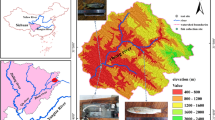Abstract
This paper presents a novel experiment for the correlation between the hydraulics and the swimming behavior of Schizothorax prenanti, a rare species of fish in southwest China, in passing a vertical slot fishway. With an acoustic Doppler velocimeter, the velocities of a physical model in the equidimension fishway in the Shaping II power station are measured. The hydraulic parameters include the hydraulic head drop, the velocity patterns and the flow rate, and the swimming behavior includes the burst-coast, the sustained swimming and the migratory path, and they are analyzed under the test conditions. The sustained swimming velocity is in the range from 0.65m/s to 1.09m/s. The estimated hydraulic head drop of each pool is calculated and is in the range from 0.08-0.11 m, which means that 2.6% slope is reasonable. For the same slope, the maximum velocity is further reduced from 1.24 m/s to 1.14 m/s by using an L shape baffle structure. The above findings are used as the basis to evaluate the hydraulic performance of the fishways, where the L shape baffle structure is expected to be effective for creating a preferencial flow for the fish. For the main stream of the pool, an “Ω” shape flow pattern is more fish-friendly, which can effectively extend the energy dissipation distance and avoid the bursting through a high velocity zone. This paper provides a useful complementary tool for practical designs.
Similar content being viewed by others
References
Huang B. S., Hong C. H., Du H. H. et al. Quantitative study of degradation coefficient of pollutant against the flow velocity [J]. Journal of Hydrodynamics, 2017, 29(1): 118–123.
An R., Li J., Liang R. et al. Three-dimensional simulation and experimental study for optimizing a vertical slot fishway [J]. Journal of Hydro-Environment Research, 2016, 12: 119–129.
Fuentes-Perez J., Sanz-Ronda F., Paredes A. et al. Modeling water-depth distribution in vertical-slot fishways under uniform and nonuniform scenarios [J]. Journal of Hydraulic Engineering, ASCE, 2014, 140(10): 06014016.
Mao X., Fu J. J., Tuo Y. C. et al. Influence of structure on hydraulic characteristics of T shape fishway [J]. Journal of Hydrodynamics, 2012, 24(5): 684–691.
Wang Y., An R., Li Y. et al. Swimming performance of rock carp and prenant’s Schizothoracin acclimated to total dissolved gas supersaturated water [J]. North American Journal of Fisheries Management, 2017, 37: 1183–1190.
Scott A., Henderson P. Seasonal and age-related migrations in the unexpectedly long-lived benthic fish the lesser weever, Echiichthys vipera (Cuvier, 1829) [J]. Journal of the Marine Biological Association of the United Kingdom, 2016, 96(6): 1287–1293.
Van Leeuwen C., Museth J., Sandlund O. et al. Mismatch between fishway operation and timing of fish movements: A risk for cascading effects in partial migration systems [J]. Ecology and evolution, 2016, 6(8): 2414–2425.
Chorda J., Maubourguet M., Roux H. et al. Two-dimensional free surface flow numerical model for vertical slot fishways [J]. Journal of Hydraulic Research, 2010, 48(2): 141–151.
Boes R., Albayrak I., Kriewitz C. et al. Fish protection and downstream fish migration by means of guidance systems with vertical bars: Head loss and bypass efficiency [J]. Wasserwirtschaft, 2016, 106: 29–35.
Bermude M., Puertas J., Cea L. et al. Influence of pool geometry on the biological efficiency of vertical slot fishways. [J] Ecological Engineering, 2010, 36(10): 1355–1364.
Tarrade L., Texier A., David L. et al. Topologies and measurements of turbulent flow in vertical slot fishways [C]. Hydrobiologia, Symposium on Hydropower, Mondsee, Austria, 2008, 609: 177–188.
Lennox R., Thorstad E., Diserud O. Biotic and abiotic determinants of the ascent behaviour of adult Atlantic salmon transiting passable waterfalls [J]. River Research and Applications, 2018, 34(8): 907–917.
Silva A., Katopodis C., Santos J. et al. Cyprinid swimming behaviour in response to turbulent flow [J]. Ecological Engineering, 2012, 44: 314–328.
Silva A., Santos J., Ferreira M. et al. Effects of water velocity and turbulence on the behaviour of Iberian barbell (Luciobarbus bocagei, Steindachner 1864) in an experimental pool-type fishway [J]. River Research and Applications, 2010 27(3): 360–373.
Guiny E., Ervine D., Armstrong J. et al. Hydraulic and biological aspects of fish passes for Atlantic Salmon [J]. Journal of Hydraulic Engineering, ASCE, 2005, 131(7): 542–553.
Lindberg D., Leonardsson K., Lundqvist H. Path selection of Atlantic salmon (salmo salar) migrating through a fishway [J]. River Research and Applications, 2016, 32(4): 795–803.
Puertas J., Pena L., Teijeiro T. Experimental approach to the hydraulics of vertical slot fishways [J]. Journal of Hydraulic Engineering, ASCE, 2004, 130(1): 10–23.
Yuan Y., Wang Y., Zhou C. et al. Tolerance of prenant’s Schizothoracin to total dissolved gas supersaturated water at varying temperature [J]. North American Journal of Aquaculture, 2018, 80: 107–115.
Barboza L., Vieira L., Guilhermino L. Single and combined effects of microplastics and mercury on juveniles of the European seabass: Changes in behavioural responses and reduction of swimming velocityand resistance time [J]. Environmental Pollution, 2018, 236: 1014–1019.
Downie A., Kieffer J. Swimming performance in juvenile shortnose sturgeon (Acipenser brevirostrum): The influence of time interval and velocity increments on critical swimming tests [J]. Conservation Physiology, 2017, 5: cox038.
Author information
Authors and Affiliations
Corresponding author
Additional information
Project supported by the National key R&D Program of China (Grant No. 2016YFC0502207), the National Natural Science Foundation of China (Grant No. 51779162).
Biography: Rui-dong An (1983-), Male, Ph. D., Professor
Rights and permissions
About this article
Cite this article
An, Rd., Li, J., Yi, Wm. et al. Hydraulics and swimming behavior of schizothorax prenanti in vertical slot fishways. J Hydrodyn 31, 169–176 (2019). https://doi.org/10.1007/s42241-019-0009-1
Received:
Revised:
Accepted:
Published:
Issue Date:
DOI: https://doi.org/10.1007/s42241-019-0009-1



